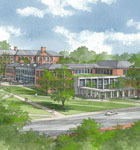If a person ever reached 200 years old, they would probably be a good candidate for a professional makeover. Buildings are no different. The Miami University campus, in Oxford, Ohio, has celebrated its bicentennial, and though only a few residence halls date back to the 1800s, the entire campus is receiving the green treatment through what’s become known as the Miami Makeover. Claire Wagner, the university’s news and public information director, explains in her own words how preserving its modified Georgian architecture is saving the school millions.

“Interest in campus sustainability has skyrocketed in recent years.” Claire Wagner, Miami University
Stay Current. For any university, every few years you need to update your facilities for the safety and comfort of your students. We have a long-range housing and dining master plan, but in 2011 we had so many projects that demanded attention … we decided to combine the projects into one large campaign, known as the Miami Makeover. Of the 40 construction projects happening on campus at the same time, many incorporated some aspect of sustainability. Upgrades to our two oldest residence halls, Elliott and Stoddard, included geothermal heating and cooling and heat-recovery systems.
Respond to Demands. Interest in campus sustainability has skyrocketed in recent years. We rely on coal to heat the campus, but over the years we’ve worked to improve efficiencies. Our students weren’t satisfied, pushing for a coal commitment. In response to the plea, in April 2011, our president, Dr. David Hodge, unveiled the university’s first statement on sustainability. Topics such as clean energy, classroom engagement, campus culture, landscaping and planning, and purchasing were included in our sustainable goals.
The student government had been asking for a new student center for the last 10 years. They wanted more space to be together, whether informally or in meeting rooms. Because the students asked for it, and they took a vote, it was determined when the Armstrong Student Center opens in spring 2014, they will accept a student fee to help pay off the debt.
Preserve Where Possible. Our architectural style is known as “modified Georgian;” the majority of our buildings are red brick with cream-colored trim around the windows. One thing we’ve been doing for the last six or seven years is instead of demolishing a building that needs to come down, we deconstruct it.
As we began the planning process for our new Armstrong Student Center, we considered tearing down the three buildings on the site and construct a new building in their place. But the project bids were too high. Architects redrew the plans to make use of the existing structures, bringing the project cost down over $30 million. Using the buildings’ shells was our first step toward sustainability.
[We also are] hoping to use 35 percent less energy per square foot to heat and cool the student center. The building’s fixtures will use less water. Motion and CO2 sensors will conserve energy. Rainwater collected will irrigate the landscaping. All these systems will contribute points as we pursue LEED certification.
Prepare for the Future. We wanted to incorporate sustainability in our academic offerings. We’ve long had an Institute for Environmental Sciences, but in 2011 we offered students the ability to co-major in sustainability. They need to declare a major, and sustainability can be a secondary major, studying concepts and applications. The university took input from more than 15 departments that contribute classes to the major. The program includes a broad perspective on social, economic, and design as well as the environmental aspects of sustainability.

